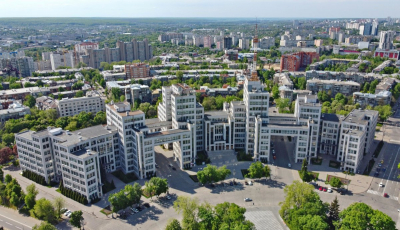The Battle of Kursk was a major World War II Eastern Front engagement between the forces of Nazi Germany and the Soviet Union near Kursk in the southwestern USSR during late summer 1943; it ultimately became the largest tank battle in history.
The battle began with the launch of the German offensive Operation Citadel (German: Unternehmen Zitadelle), on 5 July, which had the objective of pinching off the Kursk salient with attacks on the base of the salient from north and south simultaneously. After the German offensive stalled on the northern side of the salient, on 12 July the Soviets commenced their Kursk Strategic Offensive Operation with the launch of Operation Kutuzov (Russian: ) against the rear of the German forces on the same side. On the southern side, the Soviets also launched powerful counterattacks the same day, one of which led to a large armoured clash, the Battle of Prokhorovka. On 3 August, the Soviets began the second phase of the Kursk Strategic Offensive Operation with the launch of Operation Polkovodets Rumyantsev (Russian: ) against the German forces on the southern side of the salient.
The Germans hoped to weaken the Soviet offensive potential for the summer of 1943 by cutting off and enveloping the forces that they anticipated would be in the Kursk salient. Hitler believed that a victory here would reassert German strength and improve his prestige with his allies, whom he thought were considering withdrawing from the war. It was also hoped that large numbers of Soviet prisoners would be captured to be used as slave labour in the German armaments industry. The Soviet government had foreknowledge of the German intentions, provided in part by British intelligence's Tunny intercepts. Aware months in advance that the attack would fall on the neck of the Kursk salient, the Soviets built a defence in depth designed to wear down the German armoured spearhead. The Germans delayed the offensive while they tried to build up their forces and waited for new weapons, giving the Red Army time to construct a series of deep defensive belts and establish a large reserve force for counter-offensives.The battle was the final strategic offensive that the Germans were able to launch on the Eastern Front. Because the Allied invasion of Sicily began during the battle, Adolf Hitler was forced to divert troops training in France to meet the Allied threat in the Mediterranean, rather than using them as a strategic reserve for the Eastern Front. Hitler canceled the offensive at Kursk after only a week, in part to divert forces to Italy. Germany's extensive losses of men and tanks ensured that the victorious Soviet Red Army enjoyed the strategic initiative for the remainder of the war. The Battle of Kursk was the first time in the Second World War that a German strategic offensive was halted before it could break through enemy defences and penetrate to its strategic depths. Though the Red Army had succeeded in winter offensives previously, their counter-offensives after the German attack at Kursk were their first successful summer offensives of the war.
Kharkiv (Ukrainian: Ха́рків, IPA: [ˈxɑrkiu̯] (listen)), also known as Kharkov (Russian: Харькoв, IPA: [ˈxarʲkəf]), is the second-largest city and municipality in Ukraine. Located in the northeast of the country, it is the largest city of the historic Slobozhanshchyna region. Kharkiv is the administrative centre of Kharkiv Oblast and of the surrounding Kharkiv Raion. The latest population is 1,433,886 (2021 est.). The city is currently in a state of war against the Russian Federation.
Kharkiv was founded in 1654 as Kharkiv fortress, and after these humble beginnings, it grew to be a major centre of industry, trade and Ukrainian culture in the Russian Empire. At the beginning of the 20th century, the city was predominantly Russian in population, but after the Soviet government's policy of Ukrainization the city became populated mainly by Ukrainians with a significant number of Russians. Kharkiv was the first capital of the Ukrainian Soviet Socialist Republic, from December 1919 to January 1934, after which the capital relocated to Kyiv.Presently, Kharkiv is a major cultural, scientific, educational, transport and industrial centre of Ukraine, with numerous museums, theatres and libraries, including the Annunciation and Dormition Cathedrals, the Derzhprom building in Freedom Square, and the National University of Kharkiv. Kharkiv was a host city for UEFA Euro 2012.
Industry plays a significant role in Kharkiv's economy, specialized primarily in machinery and electronics. There are hundreds of industrial facilities throughout the city, including the Morozov Design Bureau and the Malyshev Tank Factory (leaders in world tank production from the 1930s to the 1980s); Khartron (aerospace, nuclear power plants and automation electronics); Turboatom (turbines for hydro-, thermal- and nuclear-power plants); and Antonov (the multipurpose aircraft manufacturing plant).
Kharkiv was given the title "Hero City of Ukraine" on 6 March 2022.

1943Aug, 23
World War II: Kharkiv is liberated after the Battle of Kursk.
Choose Another Date
Events on 1943
- 11Feb
Dwight D. Eisenhower
World War II: General Dwight D. Eisenhower is selected to command the allied armies in Europe. - 30May
Auschwitz concentration camp
The Holocaust: Josef Mengele becomes chief medical officer of the Zigeunerfamilienlager (Romani family camp) at Auschwitz concentration camp. - 19Jun
Pittsburgh Steelers
The Philadelphia Eagles and Pittsburgh Steelers in the NFL merge for one season due to player shortages caused by World War II. - 6Nov
Kiev
World War II: The Soviet Red Army recaptures Kiev. Before withdrawing, the Germans destroy most of the city's ancient buildings. - 4Dec
Josip Broz Tito
World War II: In Yugoslavia, resistance leader Marshal Josip Broz Tito proclaims a provisional democratic Yugoslav government in-exile.

 English
English  español
español  français
français  português
português  русский
русский  العربية
العربية  简体中文
简体中文 